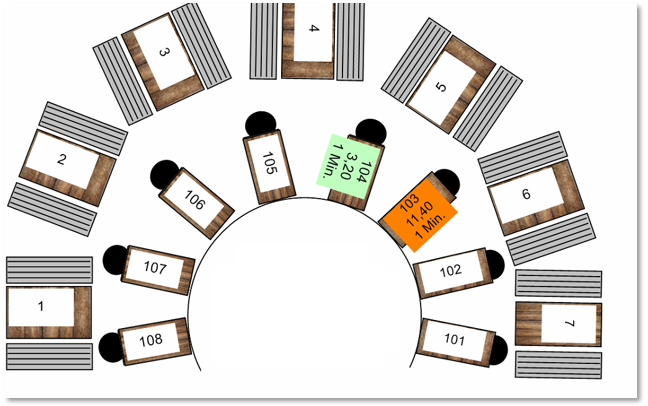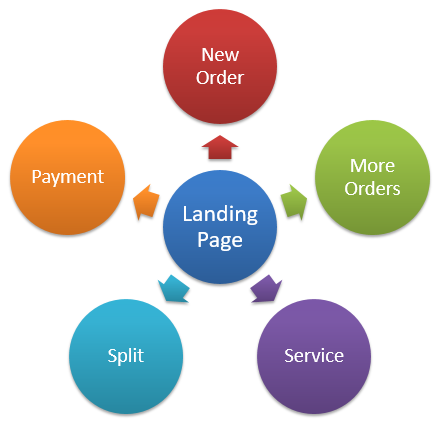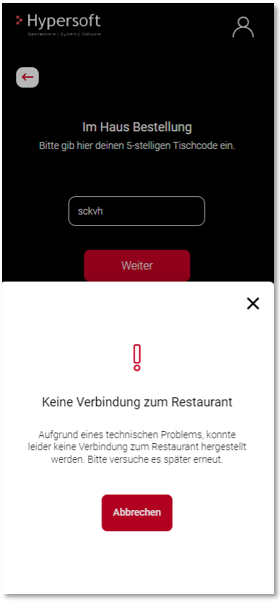Noteworthy aspects of the In-House Order

The Hypersoft In-House Order can be used from any current smartphone without having to install anything. If you use YourAPP, your users who have downloaded the app can access all functions via YourAPP. The age check can then be carried out once and saved. In addition, logged-in users (which is of course also possible via the website version) have the option of storing likes and dislikes and having them applied. Of course, cheap and fast push messages to your users are then only possible with YourAPP.
Activation or deactivation of the In-House Order in key points
To switch off or switch back on in-house ordering (or in-house ordering with group orders), you have clear to-do lists here.
Activation of "In House" orders:
-
Activation of the order type for the desired location in the webshop settings in the portal.
-
Call up CloudBOX Live-Connector settings in the MCP to retrieve the portal settings.
-
The next time Terminal Commander is restarted, it will automatically start the CloudBOX Live Connector.
-
In house orders can be placed.
Deactivation of "In House" orders:
-
Deactivation of the order type for the desired location in the webshop settings in the portal, or removal of the location from the webshop/YourAPP participation.
-
Call up CloudBOX Live-Connector settings in the MCP to retrieve the new or changed portal settings.
-
If an HS-SSP message appears, the Terminal Commander must be restarted or the CloudBOX Live-Connector must be stopped.
-
The next time Terminal Commander is restarted, it will no longer automatically start the CloudBOX Live Connector, as otherwise an HS-SSP message will be output again.
Decisions on the variants of use
Before you start planning, decide which variant you will use for In-House Order. Basically, people are naturally afraid of giving responsibility to technical systems, and in fact guests tend to use technical loopholes rather than human ones. Nevertheless, you should also trust your guests and your system. There are basic variants:
-
Pay when sending each individual order.
-
Pay when you want to leave the company.
-
Group orders as a separate variant - here you should just pay at the end of a joint consumption.
How do I know if my guests have paid when they leave the house?
If you want to expand a beer garden without regular guests or, for example, a discotheque with VIP tables with in-house ordering possibilities and in both cases guests can leave the house unnoticed, then you should rather activate payment here when ordering. Surely you know that guests can simply leave without paying even without an in-house order on the terrace - but it is at least not right.
To check whether a table has been paid, you can use the Graphic Table Overview and the NoCOO Tip Overview. The graphic table overview can generally be set in such a way that tables are given a different colour after a longer period of time without reorders, so you can already see who might want to leave soon. In addition, the unpaid sums can be shown. The overview can be used at the POS and mPOS. With the mPOS, there are also variants for Android and Apple iOS, so you can possibly place tablets or monitors in such a way that you always have them well in view.

In this example, two tables have information about the open amount and the duration since the last processing, depending on the settings.
Then there is the option of using the live tip tracking on the mPOS or the same function at the POS for a quick overview.



Evaluations for In-House Order
The bookings of the in-house ordering are evaluated together with all bookings of the POS system. For detailed evaluations, there is the Channel Report with the option Evaluate booking source (channels) in the channel report.
Automatic YourAPP hint
If you as a brand owner also use our Android or iOS YourAPP, your users will be shown the availability of the app on the landing page when they scan the code:

Access conflict between POS and user
If an in-house order process is left unfinished in the payment dialogue, the operator at the checkout receives information and can decide whether to process the process instead. The question is:
The process is blocked by another access. You can remove the lock if you are sure that only you are editing the process.
Are you the only processor and would you like to remove the block?
Risk of confusion with immediate payment
It has been shown that confusion can occur with immediate payment if transaction numbers released by payment are immediately used for new transactions.
To avoid this, we recommend activating the setting Set transaction status for immediate payment. This means that the transaction information (table number) is "occupied" even after a transaction has been completed (default is 5 minutes). This means that this internal process number is not available for new processes for this long.
Data consumption, data throughput, WLAN and Internet
The following information gives you an approximate impression of the requirements regarding data throughput, which can of course be particularly relevant for in-house ordering. Your WLAN or Internet availability should be ensured on the basis of the information provided.
Hypersoft Statement: As this is a professional application where user experience and smooth operations are paramount, the highest possible internet performance should be available.
-
With a 50 Mbit line (approx. 5 MB/s), a user would have to wait approx. 1.5 seconds to call up the shop in the WLAN. Two simultaneous users would already have to wait 3 seconds to be called up in the WLAN.... If 5 users are to call up the shop simultaneously in the WLAN and do not have to wait more than 2 seconds, the location requires at least a 150 Mbit line. If 10 users are to call up the shop simultaneously in the WLAN and do not have to wait more than 2 seconds, the customer needs a 300 Mbit line.
-
If the WLAN is also used for other services (Youtube, etc.), the connection must be designed accordingly higher.
-
Since users will not only use the shop via WLAN, but also via LTE, the required line may be halved.
-
Calling up the mobile shop with a browser (QR code scan) consumes approx. 7.7 MB the first time it is called up. This is also the amount of data that is loaded when scanning the table code in the WLAN.
-
Subsequent orders or a later call are largely handled from the browser's cache, which is why the first call is relevant here.
-
Browsing, ordering, service call etc. each consume between 0.1 and 1.0 MB and are negligible, as time is not critical.
-
The upload of a user's order is also minimal and negligible.
Introduction to the topic of in-house ordering
Upon confirmation, your brand owner app will open and the ordering process will then be carried out within the app.
That's why self-ordering is the future of the restaurant industry:
Offering in-house ordering is not a weakness in service, but a strength in digitalisation. In every type of restaurant, benefits present themselves and no one is forced to accept your In-House Order offer. By reducing the workload of your staff, the service readiness of all your guests increases, regardless of whether they use In-House Order or not. Statements and application examples:
-
A quick-service restaurant expands its service offering and reduces queuing at the POS.
-
A limited-service restaurant expands service and options without losing its character.
-
A full-service restaurant relieves its employees and offers 100% service readiness.
-
Even in fine dining, in-house orders are increasingly being used successfully.
-
A guest who wants to "quickly" order a drink with his meal does not have to wait for service, but the service brings him his order in the same time it would otherwise have taken to order.
-
A guest who wants to leave the group in advance can split (and tip) their items (not an easy thing for an operator to do in busy times).
-
A look at the dessert menu (and similar add-ons) can be done without inhibition and sales of these items increase disproportionately. Compare your Tiramisu before without and with In-House Ordering and don't be surprised about 100% increase.
-
A guest can pay and enter his or her desired address on the bill with NoCOO.
-
-
You usually have between 10% and 20% extra turnover - your employees have the tip from this extra turnover.
-
Your employees see a tangible benefit of working in your business, access to qualified staff improves.
-
Your guests perceive this as an improvement in service and are more satisfied.
-
Your guests perceive in-house ordering as smart and progressive, which improves your market opportunities.
Introduce Best Practice In-House Order in your business
In-house ordering can be integrated regardless of your business model. Work out your existing strengths and weaknesses and consult stakeholders such as staff and trusted guests to establish these facts neutrally.
-
Create a simple usage concept that starts with the high-quality presentation of your QR code.
-
Explain the motivation and opportunities to your staff.
-
Let your guests know that and how you offer in-house ordering. If this cannot be ensured, create (depending on your restaurant concept) smart info cards with symbols and procedures if necessary (like in aeroplanes for putting on the life jacket).
-
Customise your items so that they can be easily booked by your users and use a suitable assortment for this. The possibility of using Hypersoft POS and mPOS in parallel allows your operators to book other assortments and thus more complex items into the process on the smartphones of your users. Your operators remain advisors and valued service providers.
-
Reward your regular guests with the YourAPP extension for optimal customer loyalty.
Service call in In-House Ordering...
In-House Ordering has an integrated service call. You should use this accordingly to optimise communication with customers in this area as well.
Paging in In-House Ordering...
If you want your guests to pick up the order themselves, you can use digital pagers in addition to a pick-up monitor.
In-House Ordering Menu...
Use the possibility to use menu courses in in-house ordering if it is common in your concept to place more than one order for different purposes (such as starter, main course and dessert) at the same time. In this context, however, also note the setting for Important waiting time for joint ordering....
Important waiting time for joint ordering...
The Online Order Connector has a waiting time setting so that orders placed by multiple users of a table within a timer are processed as one order. The standard is 60 seconds. A check is made to see if more than one seat is involved, and the bonorder is then delayed by the number of seconds specified. I.e. each order sets an internal timer and this then triggers the receipt order automatically after n seconds. Examples with the Bonorder Delay setting in 60 seconds:
-
A guest is the only one logged into a table (via QR code scan) and orders are processed immediately.
-
Two guests are logged into a table, the first one orders. The system waits 60 seconds for the second guest to order. If the order comes within the 60 seconds, both are processed together and also common menu courses (if used) are taken into account for grouping. If the second guest does not order within 60 seconds, the first guest's order is processed alone after the 60 seconds (with menu courses if available). If the second guest orders after 60 seconds, his order will be processed like that of the first guest. The production/kitchen still has the option of intelligently combining the order on the basis of the order receipts.
-
If there are three guests at the table and the second guest orders 50 seconds after the first, the timer is set to zero again, so that the third guest also has 60 seconds after the second guest has ordered. If the third guest orders 10 seconds after the second, the system still waits until 60 seconds have elapsed because another order could be placed.
Waiting for orders or collecting them into a joint order is already set very well at 60 seconds. Of course, depending on the concept, there may be better settings, which is why you can adjust the value Receipt order delay in seconds to your requirement accordingly.
Important redundancy of the internet connection
All eSolution services require a stable internet connection. Especially for in-house ordering, your location should be securely connected to the internet.
The more important a functional internet connection becomes for you, the more securely you should provide it. This can be done, for example, simply with a router that switches to an appropriately designed SIM card if the DSL connection fails.
In-House Ordering Landing Page
The landing page in this case is the page that is called up from the information within the QR code and is the first thing that is displayed to your users after they have scanned or entered the table code. The landing page is the focal point of all available actions and always directs your users back to it until the table is completed.

The landing page can be reached at any time via the table icon in the title bar and the label on the start screen:


The landing page shows the user the current table number, his user name, as well as the number and amount of items booked (by all users and service staff) on this table.

Statement on "voluntary payment
It is unusual to leave the payment to the guests and of course there can be uncertainty about what will happen if you lose track of the payment. As a rule, guests could leave the location without paying even without your In-House Order offer - but of course they do not. Also because leaving without paying can constitute fraud by default (in Germany under §263 StGB). So far, we could not see a significant increase in non-payment for digital concepts. In fact, payment rates and turnover may actually increase, as human error is largely eliminated and fraud is no longer an issue here (as guests take care of booking everything).
To get an overview of open processes you can use the Graphical Table Overview, which is included free of charge in every Hypersoft POS. If appropriate, use a "reminder" screen that is clearly visible when leaving the site. In the end, the users also have respect, because they order from you with their mobile phones. If you are indeed affected for conceptual reasons, you can activate payment as mandatory for every order.
The Hypersoft programme ensures as far as possible that no accidental non-payments occur by using the methods shown above and other methods for payment and splitting.
Technical interaction with the POS system
Operators at the POS or mPOS can view and edit an in-house order table at will. Each user has a place number so that they can also be quickly separated.
Users are automatically assigned a seat when they enter a table, in the order in which QR codes are scanned (seat 1, seat 2, seat 3, etc.). Your users receive a so-called temporary user token (unique identifier) on their mobile device. The app or the shop shops the table number and the space within the user token. If the user switches off their mobile phone or the application goes into standby mode, the connection to your in-house order server at Hypersoft is disconnected, but the user token still remains until the table is completed or paid for.
If the mobile phone is reactivated, the server recognises the user by token and restores the table and his seat number.
Disconnections...
If a connection to the POS cannot be established, the following message will appear after scanning the QR code:

If the connection to the POS is interrupted after the user has already logged on to a table, the following message appears:

Disconnections should not happen by default. Of course, the user's mobile device and your site system must be connected to the Internet, as your CloudBOX (your eSolutions server at Hypersoft) is also accessed via the Internet. These are the three linked components for successful in-house ordering.
Information on value added tax
In-House operations automatically apply the In-House VAT data you set. If required, you can also Set up function outside the house.
Transaction responsibility for in-house ordering
Operations that are not yet assigned to an operator(no operation responsibility) are displayed in white in the operation overview. These can be processes from in-house ordering. If operations are created from the in-house order or are involved with it, they are additionally given the letter O when displayed, a table 2 is then displayed as OT 2 instead of T 2.
If an operator opens a task that does not yet have task responsibility, this operator receives the task responsibility. This also assigns any tips to him, which you should configure accordingly.
Back to the parent page: eSolutions In-House Order